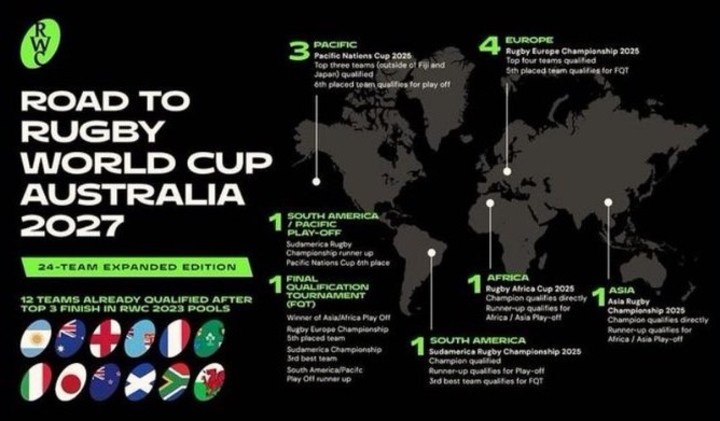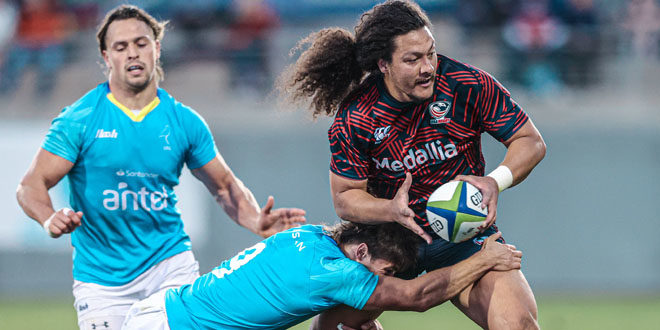Rugby World Cup 2027 will be the first expanded tournament since 1999. Expansion from 20 to 24 teams means four additional slots and brings with it geographical considerations as to who qualifies and how.
ARN has learned that World Rugby have altered the process for Rugby World Cup 2027. It sees winners and also losers. Asia is a winner. The Asia 1 team will qualify directly for Australia 2027. Regional powerhouse Japan have already qualified and, thus two Asian countries will compete at a Rugby World Cup for the first-time.
In addition to Asia, Rugby Europe will also directly benefit from the expansion. Teams are to qualify as Europe 1, Europe 2, Europe 3 and Europe 4.
Africa retain one spot while Oceania and the Americas have changed. There will not be Americas qualifies in the form of South America 1 vs North America 1; instead, there be a combined regional qualification between North America and Oceania in the form of the Pacific Nations Cup (PNC). Three of Samoa, Tonga, Canada and the USA will qualify as PNC 1, PNC 2 and PNC 3. Fiji and Japan have already qualified.
As displayed in the following table, and again at the bottom of the article, there are twelve automatic qualifiers. These are the teams who finished 1st, 2nd and 3rd in their respective pools at Rugby World Cup 2023. The table also shows the ten regional qualifiers. This leaves two final places which will be determined via interregional play-off matches.
| REGION | QUALIFIER | ALREADY QUALIFIED |
| Africa | Africa 1 | South Africa |
| Asia | Asia 1 | Japan |
| Europe | Europe 1, Europe 2, Europe 3, Europe 4 | England, France, Ireland, Italy, Scotland, Wales |
| Oceania + North America | PNC 1, PNC 2, PNC 3 | Australia, Fiji, New Zealand |
| South America | South America 1 | Argentina |
The team who finishes bottom in the PNC (excluding Fiji and Japan) will not be eliminated. This team (Samoa, Tonga, Canada and the USA) will take-on South America 2 in a series in which the winner qualifies for the World Cup. The loser of this inter-regional series will enter repechage for a last opportunity.
The repechage series will again feature four teams. Indications are that they are to be (a) Europe 5, (b) the South America vs PNC loser, (c) South America 3 and (d) the winner of a play-off between Asia 2 and Africa 2 winner.
What is the most likely scenario as to who will thus be the twelve successful teams to join the pre-qualified twelve at Rugby World Cup 2027?
From Asia it is Hong Kong as favorites ahead of South Korea. From Europe it is Georgia, Portugal, Spain and Romania. Africa 1 is expected to continue as Namibia. The three Pacific Nations Cup sides are likely to be Samoa, Tonga, and the USA with Uruguay qualifying as South America 1.
This represents a loss for South America who World Rugby have demonstrably handed a carded qualifying pathway despite the outcomes of RWC 2023 qualifying. On the one hand, Hong Kong and the USA are big winners. On the other hand, Chile are big losers.
The model selected by World Rugby implies that the winner of South America 2 vs Pacific Nations Cup 4 would be a match-up between Chile and Canada. Los Cóndores are positioned at present as favorites for that contest. In other words, Repechage may well be between Holland, Canada, Brazil and Kenya.
The expansion to 24 teams has come with a reduction in qualifying competitors, at least for the initial phases. From the Americas, for instance, there is no place for prior Rugby World Cup qualifiers participants such as the Bahamas, Bermuda, the Cayman Islands, Guatemala, Guyana, Jamaica, Mexico or Trinidad & Tobago.
There may be time for such teams to compete in a different format to prior Rugby World Cup Qualifying campaigns. For instance, a North American regional team such as Mexico could advance to face the South American 3 side in a play-off with a spot in repechage on the line. A similar process could be used with an outcome such as the Cook Islands playing against South Korea to determine the Asia 2 competitor to face Africa 2.
World Rugby has organized the Rugby World Cup 2027 Qualifiers so that they conclude by November 2025. The reason for this is to subsequently invest in the qualified teams. This comes as an effort to lift the levels of lower ranked teams at the World Cup.

 Americas Rugby News Rugby news from across the Americas!
Americas Rugby News Rugby news from across the Americas!




